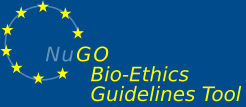- Home
- NuGO Guidelines
-
Definitions
-
Examples
-
Background
-
This is a static version of the NuGO Bioethics Guidelines Tool from 2007. Some links may be outdated. Searching is disabled. Please contact the authors for comments or questions
Definition
Anonymous, unidentified
Biological materials that had been were originally collected without identifiers and are impossible to link with their source are anonymous, unidentified. This status of confidentiality is very unusual in nutrigenomics research and therefore was not included in the guidelines.
There is one comment on this page:
The absolute anonymisation of a sample is usually impossible because the analysis of a reference sample would serve to re-identify the original sample.
- Re-identification is currently so cumbersome that the identity of a donor is factually impossible to restore from a sample alone.
The German data protection law (BDSG), [see 23] only requires factual anonymisation, the validity of which may have to be reassessed when technical circumstances change.
For safe, long-term use of biomaterials, donors should be asked to give their consent to a pseudonymised use of their samples.
A balance has to be sought between the fundamental rights of freedom of research and informational self-determination.
The risk of re-identification can be minimized by technical and organisational precautions, including
- data encryption
- use of firewalls
- monitoring
- separate storage
- splitting of responsibilities
- contracts
- SOPs
[ Comment by Prof. Dr. Michael Krawczak, www.tmf-ev.de, 2007-09-17 12:00:00 ]
